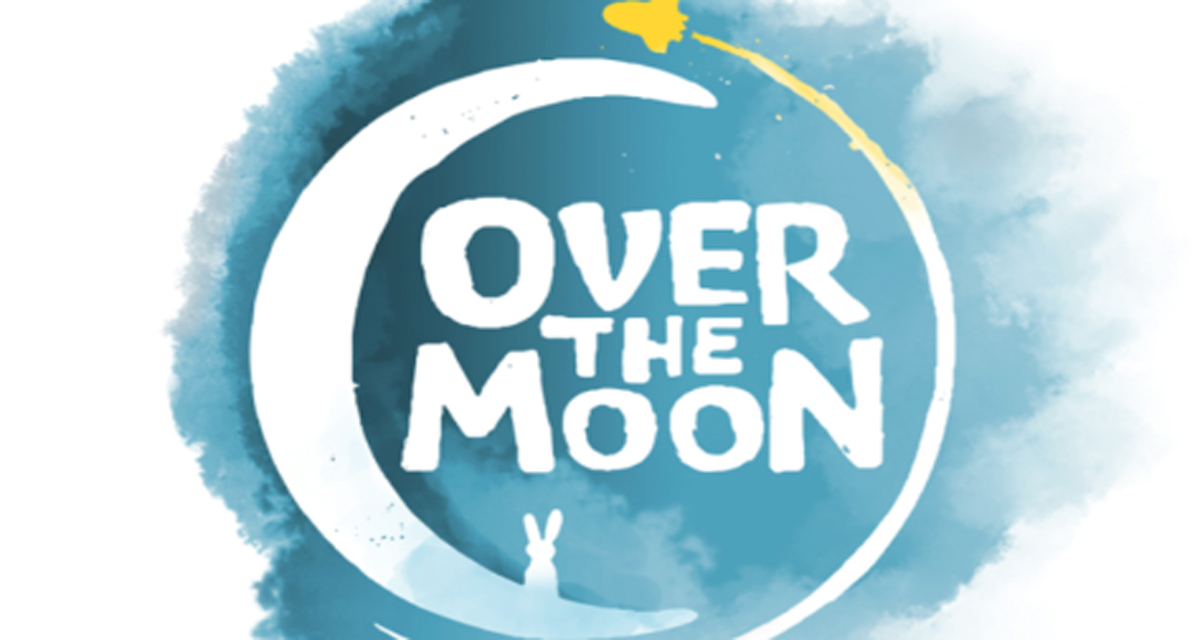With Return To Neverland recently making a return trip to DVD – in a brand-new Pixie-Powered edition – Animated Views’ reprints Jeremie Noyer’s original-release discussions with singer-songer Jonatha Brooke and score composer Joel McNeely, both responsible for differing aspects of the musical accompaniment to the film.
Jonatha Brooke: Pixie-Powered Singer-Songwriter
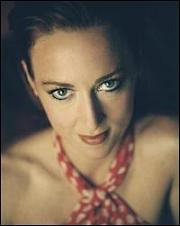 An icon of the pop-rock scene, Jonatha Brooke forged her musical universe from the 80s on through The Story, a duet with Jennifer Kimball, and then solo success. Hard to believe at first, then, that her style would ever fit the world of Peter Pan, but the creators of Return to Neverland took the risk and the collaboration worked – she brought an unexpected tenderness, intimacy and youth to the classic characters through her beautiful interpretation of The Second Star to the Right and I’ll Try, the original song she wrote for the new film. It is our pleasure to welcome this lady of pop-country for a chat about her moving contributions to the film.
An icon of the pop-rock scene, Jonatha Brooke forged her musical universe from the 80s on through The Story, a duet with Jennifer Kimball, and then solo success. Hard to believe at first, then, that her style would ever fit the world of Peter Pan, but the creators of Return to Neverland took the risk and the collaboration worked – she brought an unexpected tenderness, intimacy and youth to the classic characters through her beautiful interpretation of The Second Star to the Right and I’ll Try, the original song she wrote for the new film. It is our pleasure to welcome this lady of pop-country for a chat about her moving contributions to the film.
Animated Views: Your songs sound beautiful in Return to Neverland!
Jonatha Brooke: Thank you! I think it’s a very sweet movie and I love the way that they used my songs!
AV: Your musical world seems to be very remote from Disney’s classic songs and yet you perfectly fit into it. How do you explain that?
JB: That’s a good question. I love writing songs and I love getting assignments for different kinds of songs; songs that I wouldn’t naturally write for myself. And I had a friend who was working at Disney at the time. Her name is actually Bambi.
AV: You mean Bambi Moe, former VP in charge of the music for Disney sequels and animated series?
JB: Right. She was a big fan of my records and she’s the one who called me up saying: “I think that you would be perfect. We need a song that sort of describes the emotional transformation of this 12-year old girl in the movie. Why don’t you give it a shot?” So, I wrote this song and they loved it and that became a huge part of how they made the movie work because they used the song at two different scenes that are very important for the film. The song became part of the life of the whole movie, which was very flattering for me. You know, I think it was the perfect assignment for me because a lot of the songs that I write for myself deal with complicated transformations, and with conflict between love and anger, all the range of human emotions. So, for me it was such a beautiful assignment because I love writing emotion songs.
AV: When did you write the song, I’ll Try?
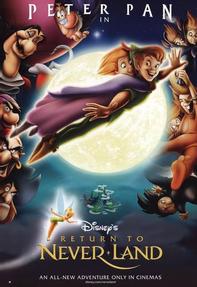 JB: I think I wrote it almost three years before the movie was finished. So, it went through many, many different transformations. There were two different directors, maybe three, I think. They kept going back and changing things, and it turned out that they did end up creating some of the animation around my song.
JB: I think I wrote it almost three years before the movie was finished. So, it went through many, many different transformations. There were two different directors, maybe three, I think. They kept going back and changing things, and it turned out that they did end up creating some of the animation around my song.
AV: Was everything you wrote used in the production?
JB: Yes. Everything that I did, they used. I sang the first song that you hear, The Second Star to the Right. That was the first thing that I sang for them. Then I wrote I’ll Try. That were the only two that I was involved with.
AV: Did you come to meet any of the creators of the film?
JB: I never met them during the production. I was very distant because also they went through two or three different producers. I only met them, actually, at the Premiere! It’s been wonderful to have such a creative freedom. They really let me do exactly what I intended to do. They were very generous with honoring the way I saw the song. I think they appreciated the uniqueness of how I write.
AV: So, how was the place of I’ll Try chosen within the story?
JB: When I first wrote the song, I knew it was going to be that first scene where Jane doesn’t want to leave London and she’s angry with her mother for letting her go. She feels like she’s a grown-up and she doesn’t believe in Peter Pan anymore. So I knew that that was where the song would definitely be used. So I wrote it originally for that particular scene. And then, when I knew more about the way the story was developing, I wrote another verse and a bridge to help describe the last scene where Jane is finally understanding what she has to do to get back home, that she has to believe and she has to learn how to fly and she has to save Tinker Bell and she has to save Peter!! So I wrote what I thought that last scene needed in the last verse.
AV: How would you personally describe this song, musically?
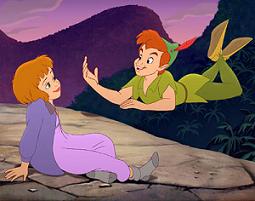 JB: Oh, goodness! I just love it! It sounds very strange but I find it very poignant. It’s just a really moving, subtle melody. I love the piano part that I wrote because I think it’s got a lot of interesting harmony to it, but it’s still very straightforward in the way it balances the melody. It’s just a really clear song to me. I’m just proud of how it conveys so much emotion in a very small kind.
JB: Oh, goodness! I just love it! It sounds very strange but I find it very poignant. It’s just a really moving, subtle melody. I love the piano part that I wrote because I think it’s got a lot of interesting harmony to it, but it’s still very straightforward in the way it balances the melody. It’s just a really clear song to me. I’m just proud of how it conveys so much emotion in a very small kind.
AV: How did you create it?
JB: My goodness! I think I had the lyrics first. Disney sent me one little scene that they had in sort of pencil animation, very, very crude idea, and I wrote the lyrics down as I was watching the scene. I think they already had the line “there is no such thing as faith and trust and pixie dust”, they already had that in the movie, so I used that as part of the lyric. And then the melody came pretty easily after that. It was just one of those songs that falls into place very easily. It really wanted to be written! I love those! They’re the good ones! My first demo was just my voice and myself playing the piano. So, I wrote the piano part and I was very, very attached to exactly keeping the piano part the way I played it. So Aaron Zigman [later score composer for Bridge to Terabithia], who arranged the orchestra, transcribed my piano part exactly and he played it during the recording session for the single. It was so wonderful to hear somebody else play my part! And then I sang it live as we were recording the basic track with the band and he played the piano part. He built the whole arrangement around the piano part, which is very, very sweet, and I think it became the perfect sort of enhancement for the song and kept it in that very intimate space.
AV: In that arrangement, the drum kit balances between the brushes and the sticks, which makes the sound balance between softness and energy. So, it’s not only beautiful, but also meaningful!
JB: That was Stewart Levine who produced the song and it was his idea to really have a dynamic range for the drums, that they had to be very intimate in the verses, with that beautiful brush pattern. But the chorus definitely needed to be a pop chorus. The drummer also was just incredible. His name is Greg Bissonnette.
AV: At first sight, it seemed surprising to appeal to pop-country for a Peter Pan movie. What do you think about that?
 JB: I think a good song is a good song, no matter what kind of treatment you give it. If it’s a melody that people can really sing-along to and a lyric that is strong enough to remember, these are the kind of songs that last forever. Of course, I can only hope that my song will last a little while! But I think that’s what pop music is. It’s something that you can’t necessarily describe. It’s something that happens and it connects to the imagination of the public in some way that you can’t plan. So, you know, the songs that I’ve written that are the most clear and the most simple and the most straightforward, those are the songs that really, really reach people. So, hopefully, this one is going to be one of those! I can only hope!
JB: I think a good song is a good song, no matter what kind of treatment you give it. If it’s a melody that people can really sing-along to and a lyric that is strong enough to remember, these are the kind of songs that last forever. Of course, I can only hope that my song will last a little while! But I think that’s what pop music is. It’s something that you can’t necessarily describe. It’s something that happens and it connects to the imagination of the public in some way that you can’t plan. So, you know, the songs that I’ve written that are the most clear and the most simple and the most straightforward, those are the songs that really, really reach people. So, hopefully, this one is going to be one of those! I can only hope!
AV: Jane is really a new kind of heroine, far from Wendy’s “kind mother” personality. What do you think about this new kind of feminine characters?
JB: She’s a very strong character and I like that. She’s very stubborn and very strong. She has troubles and trials and she makes her way and in the end, she rises to the occasion. She’s a heroine. I think it’s good, it’s a big step because, in the end, when Jane gets to become one of the Lost Boys, that’s a great addition to the canon in way. She’s allowed into the boys’ club. It’s really cool, really forward-thinking of Disney!
AV: I’ll Try also seems to be aimed at Wendy.
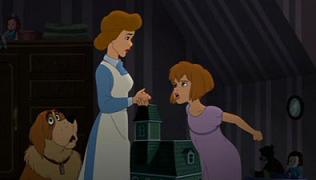 JB: Well, I think that, the first verse especially, it’s Jane speaking to her mother saying: “don’t treat me like a child. I’m grown-up now. I can take care of myself. I’m trying but I think your stories are silly and I don’t believe in Peter Pan. I keep trying but I don’t see what you see.” And even though, in the last verse, “I can finally see it; now I have to believe”, it’s more to everybody, it is also definitely like she was talking to her mother. It’s definitely like a mother-daughter conversation.
JB: Well, I think that, the first verse especially, it’s Jane speaking to her mother saying: “don’t treat me like a child. I’m grown-up now. I can take care of myself. I’m trying but I think your stories are silly and I don’t believe in Peter Pan. I keep trying but I don’t see what you see.” And even though, in the last verse, “I can finally see it; now I have to believe”, it’s more to everybody, it is also definitely like she was talking to her mother. It’s definitely like a mother-daughter conversation.
AV: So, this song is first about rejecting all the values of the original film, to better embrace them in the reprise!
JB: You’re very kind. Yes, that is what it does. It pulls away a little bit from the original concept, just like a little girl pulls away from a family, and then, like we all do, I guess, as we grow up, we realize that family is the most important thing. We understand that there’s no place like home. It’s that push-and-pull of wanting to be on your own and be strong, and knowing that there will always be a child inside of you, and that that’s a good thing. You can’t do it alone. You have to remember where you’ve come from. So, the movie remembers where it came from, and so does Jane!
AV: Indeed, as the use of The Second Star to the Right also confirms. You provided a very intimate rendering of that classic Disney song. Can you tell me about that aspect of your interpretation?
JB: I think they were wanting it to have that intimacy and to be very poignant because the movie is set in wartime in London, right before the bombing. So it had to be more intimate and more poignant than in the first one. It’s much more personal, I think. And that’s why we chose the very beginning to have an a Capella as it starts.
AV: You know, for the bridge of that song, they wrote three different versions of the lyrics. In the 1951 sheet music, you have “lead me to the one who loves me”. In the 1953 film, it’s “lead us to the land we dream of”. And in your version, it’s “lead me to the land I dream of”.
 JB: I didn’t know there were so many versions. But I think it makes sense because the whole movie is about Jane trying to figure out how to get back home. So, that’s probably why those lyrics were the ones that they gave to me.
JB: I didn’t know there were so many versions. But I think it makes sense because the whole movie is about Jane trying to figure out how to get back home. So, that’s probably why those lyrics were the ones that they gave to me.
AV: In a way, through that song, and not only through I’ll Try, you embody Jane.
JB: Yes, I do. That’s what I was definitely feeling when I was singing it. I felt like: “well, this is really about Jane’s story.”
AV: So, it’s a new version of the classic song, but at the same time, it sets a strong connection with the original film. In a true Disney fashion, it sounds like a link between tradition and modernity. Do you agree with that?
JB: I do agree with that. I think they did a beautiful job of creating a new story but being very, very true to the style of animation from the original and also by using the song again, but treating it in a very different way and bringing my voice to the song. I think it’s very classy!
AV: Would you like to work again in the field of animation?
JB: Oh yes! Actually, Disney called me some years ago when they were doing a sequel to Dumbo. I’ve written a song for that movie, it was a very sweet kind of lullaby, but I’m not sure it will be released…
AV: Return to Neverland tells us that dreams are necessary to life. Do you agree with that?
JB: I don’t want to believe it’s a dream. There is a Neverland!
Joel McNeely: Scoring with Faith and Trust and Pixie dust
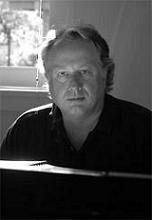 If there have been a lot of discussions over Disney’s sequels, the quality of their musical scores has never been questioned. The fact is that most of them have been written by the same talented hand: Joel McNeely. From Return to Neverland to the upcoming Tinker Bell Movie, we owe him Jungle Book 2, Mulan II, Pooh’s Heffalump Movie, Lilo & Stitch 2, The Fox and the Hound 2 and Cinderella III. But he’s also famous for his live-action scores for the likes of Iron Will, Young Indiana Jones and the Attack of the Hawkmen, James Cameron’s Ghosts of the Abyss, Holes, his videogame score for Star Wars: Shadows of the Empire, and James Cameron’s (again!) Dark Angel TV series. That’s an impressive resume for a musician who composes and conducts with rare flair, energy and elegance. And now he’s “one of us”, joining Animated Views to speak about his work on Return to Neverland!
If there have been a lot of discussions over Disney’s sequels, the quality of their musical scores has never been questioned. The fact is that most of them have been written by the same talented hand: Joel McNeely. From Return to Neverland to the upcoming Tinker Bell Movie, we owe him Jungle Book 2, Mulan II, Pooh’s Heffalump Movie, Lilo & Stitch 2, The Fox and the Hound 2 and Cinderella III. But he’s also famous for his live-action scores for the likes of Iron Will, Young Indiana Jones and the Attack of the Hawkmen, James Cameron’s Ghosts of the Abyss, Holes, his videogame score for Star Wars: Shadows of the Empire, and James Cameron’s (again!) Dark Angel TV series. That’s an impressive resume for a musician who composes and conducts with rare flair, energy and elegance. And now he’s “one of us”, joining Animated Views to speak about his work on Return to Neverland!
Animated Views: Mr. McNeely, do you believe in magic?
Joel McNeely: Yes, I believe in magic. There’s a lot of magic in Return to Neverland and I tried to follow that. I tried to have the music be true to the Peter Pan tradition and just kind of, you know, help bring the story alive.
AV: How did you come to work on Return to Neverland?
JMN: Well, I have a long relationship with Matt Walker, the VP in charge of music at DisneyToon Studios, who is a long-time colleague and friend. I was also helped by my agent, Vasi Vangelos. So, I submitted some music along with many other people and I was lucky to get the job!
AV: When in the process were you brought into the production?
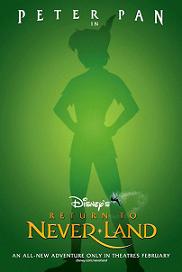 JMN: Gosh, maybe three months before we recorded the music. For the most part, the movie was ready by the time we recorded but there were certain sequences that were not finished. So, for those we had to kind of wait and have another scoring session.
JMN: Gosh, maybe three months before we recorded the music. For the most part, the movie was ready by the time we recorded but there were certain sequences that were not finished. So, for those we had to kind of wait and have another scoring session.
AV: How did you work with the creators of the film?
JMN: Oh, very closely. You know, Kevin Lima, who came in at the end of the production to give a hand, has a very fine musical sense and he knew what he wanted. I would write some music and create a demo. Then he would come and listen to it and we would talk about it and he would give me his thoughts on it. Then, I would change it and play for him again. He pretty much heard everything before we got to the orchestra.
AV: Your score for Return to Neverland is very thematic. Can you tell me about that?
JMN: Absolutely. It’s absolutely the case. You know, I was trained in the classical sense of the composer. What I was doing in Dark Angel before working on that film didn’t utilize that as much as some other films like this. So, my score is very thematic. I had about four central themes and almost everything was in one way or another derived from those themes.
AV: Can you tell me about that training?
JMN: Sure! For my high school training, I went away to a school called the Interlochen Arts Academy. So I got concentrated on music training in my high school. Then I went to College in Miami, and I went to grad school at the Eastman School of Music in New York.
AV: The richness of your music – especially the counterpoint – is very impressive and unusual for a direct-to-video movie.
JMN: It is. You don’t hear a lot of counterpoint in movie scores these days. You know, the composers I admire the most all used counterpoint in one way or another, starting from Bach. What interests me in music is complexity. So, in order to keep myself interested, that’s the way I write. I always try and add something contrapuntal going on.
AV: It’s a true tour de force, all the more since animation requires a lot more attention to details than live action. How did you deal with that?
JMN: You know, the trick is always to have the music support the movie. The danger is for the music to become so complex that it overwhelms the action of the scene. And I’m always very careful about that. So, you know, many times, if I want to write something that’s a little more complex, I have to really second-guess myself to make sure that I’m now trying to write the music for the music’s sake instead of supporting the film. But generally, with animation, you have room to use counterpoint because an animated film supports a little more of a complex kind of score.
AV: Your music is also very much inspired by classic swashbuckling film music.
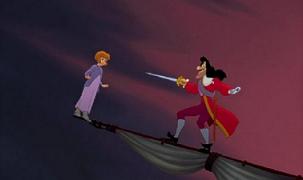 JMN: Yes. It’s stylistically based on an older style of film scores, some scores from the 30s and the 40s like Korngold [The Adventures of Robin Hood].
JMN: Yes. It’s stylistically based on an older style of film scores, some scores from the 30s and the 40s like Korngold [The Adventures of Robin Hood].
AV: In that spirit, your score for Return to Neverland seems to be all live orchestra.
JMN: There are some electronics in a couple of the pieces but not largely. I wanted this to be a classic Disney score. Disney has such a rich tradition of wonderful music for their animated films that I thought it’s such a responsibility. From the moment I started talking with the filmmakers, we all agreed that this had to be a real, fun, over-the-top orchestral score. I was happy to be able to shed all the electronics and get back to my roots!
AV: Speaking of roots, what do you think about the original Peter Pan score composed by Oliver Wallace?
JMN: Oh, I think it’s brilliant! I love it! I was all the more intimidated doing this sequel. I wanted it to take place within the tradition of the original, you know. I didn’t want it to be a poor cousin to the original.
AV: The film opens with a wonderful overture that references the very themes of the original Peter Pan movie. Can you tell me about it?
 JMN: That piece was the idea of Kevin Lima. He came up with the concept of the animation of Tinker Bell flying through the clouds and cutting out the different shapes of the different characters from the first movie and that each time that a character would be cut out in the clouds there would be a theme to echo that character. This came up very late in the production process. So, what Kevin asked me to do is to write a piece of music first because they were working on the animation, but at that point they didn’t have anything really to show me other than storyboards. So Kevin said: “just go ahead and write a piece of music and we’ll do the animation to the music”. So that’s what we did. I wrote that piece of music first and I sent it to them and they finished the animation to the music. It was very exciting!
JMN: That piece was the idea of Kevin Lima. He came up with the concept of the animation of Tinker Bell flying through the clouds and cutting out the different shapes of the different characters from the first movie and that each time that a character would be cut out in the clouds there would be a theme to echo that character. This came up very late in the production process. So, what Kevin asked me to do is to write a piece of music first because they were working on the animation, but at that point they didn’t have anything really to show me other than storyboards. So Kevin said: “just go ahead and write a piece of music and we’ll do the animation to the music”. So that’s what we did. I wrote that piece of music first and I sent it to them and they finished the animation to the music. It was very exciting!
AV: Were you involved in the arrangement of the songs?
JMN: No. The songs were largely done when I came aboard. The only arrangement that I did was Second Star to the Right. Everything else was done before.
AV: In the original film, Peter Pan had a flute theme and a You-Can-Fly theme. Why did you want to give him another flying theme, like you did?
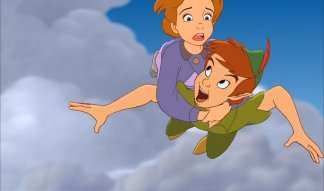 JMN: It was the choice of the filmmakers in that they wanted to give respect to the original at the beginning and at the end. But for the film itself, we wanted it to have its own integrity and its own new material. And I also think that it makes it more effective when at the end you come back to Second Star to the Right. I think it’s very emotional at the end, when that song, which is such a brilliant song, is brought back. So, from the very beginning, we decided we were going to have our own themes.
JMN: It was the choice of the filmmakers in that they wanted to give respect to the original at the beginning and at the end. But for the film itself, we wanted it to have its own integrity and its own new material. And I also think that it makes it more effective when at the end you come back to Second Star to the Right. I think it’s very emotional at the end, when that song, which is such a brilliant song, is brought back. So, from the very beginning, we decided we were going to have our own themes.
AV: Captain Hook also has a new theme, and this one is a little more menacing than the original one.
JMN: Well, I think he was a little more menacing in this movie.
AV: Your score is also much more lyrical than the original one.
JMN: Well, as I said, I wanted this to be an old-fashioned score and the music that I love from the classic film scores is stemming from the great tradition of European classical music. Composers like Korngold and Rosza were directly out of the tradition of Mahler and you could draw the lineage back to Brahms and the great composers of the 19th century. So, yes, I wanted it to be very much in that tradition. As you can see in the movie, there is this one particular character, the lead character, Jane who, initially in the story is a little on the strident side. She’s a bit abrasive. So, we had to find a way to tone that down and make her a little more childlike. So, the lyricism is my attempt to soften her character.
AV: Jane’s theme is not derived from the song I’ll Try. Can you explain this choice?
JMN: Jane has an instrumental theme. It’s called the Home theme and that’s the more lyrical theme I was just mentioning. I felt like Jonatha’s song stood on its own. We used it twice in the movie and I thought that those places were very special, so I didn’t want to run the risk of overusing it. So, I felt like I needed to leave that alone and have its own integrity.
AV: Can you tell me about that Home theme?
JMN: The whole movie is about trying to get home and rediscovering what ‘home’ means. So, every time she starts thinking about the things that are important to her, Home is what you can hear. And that theme brings a very nice conclusion to the film, just before Second Star to the Right, when they’re all flying back to London.
AV: You conducted the orchestra, and I must say it’s one of the most energetic performances I’ve ever heard!
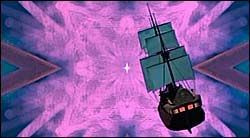 JMN: The orchestra sounds good, doesn’t it? Well, I write my music for me to conduct it. I know what I want to get out of a scene and I love to conduct and I’ve always conducted my music. I feel like there’s only so much one can put on a page and then after that, the interpretation is also brought out by the person on the podium. As an example, the final session of the recording of the movie was done a month later after the first session because they had to finish animation. This was in October, a couple of weeks after the September 11th attack in our country. At that point, nobody would get into an airplane, nobody was going anywhere. So, I was not able to go over to London to finish the session. So they had to hire another conductor to finish that final day. And they hired a very accomplished conductor who came in and did a fine job, but it’s not the same as if I had been there because, as I said, you can only put so much on the page and then the rest of the interpretation comes from the conductor. I was the only one who knew what I wanted to pull out of the score, and that was impossible for somebody else to do on such a short notice. So, I do feel the conducting is a big part of it. I also think that the orchestra was just an amazing orchestra. They just played so beautifully and so energetically. You know, orchestras these days have to play a lot of hold-ons in film scores. They’re not given challenging parts to play all the time. So when they do get challenging parts, they’re excited, and you can hear that in their playing.
JMN: The orchestra sounds good, doesn’t it? Well, I write my music for me to conduct it. I know what I want to get out of a scene and I love to conduct and I’ve always conducted my music. I feel like there’s only so much one can put on a page and then after that, the interpretation is also brought out by the person on the podium. As an example, the final session of the recording of the movie was done a month later after the first session because they had to finish animation. This was in October, a couple of weeks after the September 11th attack in our country. At that point, nobody would get into an airplane, nobody was going anywhere. So, I was not able to go over to London to finish the session. So they had to hire another conductor to finish that final day. And they hired a very accomplished conductor who came in and did a fine job, but it’s not the same as if I had been there because, as I said, you can only put so much on the page and then the rest of the interpretation comes from the conductor. I was the only one who knew what I wanted to pull out of the score, and that was impossible for somebody else to do on such a short notice. So, I do feel the conducting is a big part of it. I also think that the orchestra was just an amazing orchestra. They just played so beautifully and so energetically. You know, orchestras these days have to play a lot of hold-ons in film scores. They’re not given challenging parts to play all the time. So when they do get challenging parts, they’re excited, and you can hear that in their playing.
AV: Was it your choice to record at Abbey Road?
JMN: It wasn’t my choice to record outside of the US. That was the Studio’s. But in London, Abbey Road is the most wonderful studio. I just adore that studio!
AV: Return to Neverland was your first Disney animated film, but you had already worked for the Mouse, on Iron Will, in 1994.
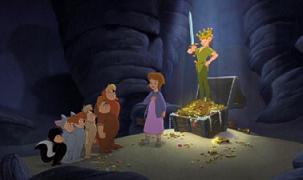 JMN: Well, Iron Will was my first big movie. I was just scared. I mean that’s true, I was scared! I wrote a lot of music that was very close to the temp and in the end I was disappointed about that, that I didn’t have the courage to stray from the temp. But the Studio very much liked what the temp was doing. It was a match of, you know, Bruce Broughton, John Williams… There was a lot of different music in that. You know, as a young, first-time composer, I was terrified. So I wrote music that was very derivative. At the same time, though, it was a great learning experience. You know, there is some music that is original for me in that score, that’s not derivative, it’s very much my music in that, and I started a great relationship with the director, Charles Haid, who is now one of my dearest friends. So, you know, it was a positive and a negative experience.
JMN: Well, Iron Will was my first big movie. I was just scared. I mean that’s true, I was scared! I wrote a lot of music that was very close to the temp and in the end I was disappointed about that, that I didn’t have the courage to stray from the temp. But the Studio very much liked what the temp was doing. It was a match of, you know, Bruce Broughton, John Williams… There was a lot of different music in that. You know, as a young, first-time composer, I was terrified. So I wrote music that was very derivative. At the same time, though, it was a great learning experience. You know, there is some music that is original for me in that score, that’s not derivative, it’s very much my music in that, and I started a great relationship with the director, Charles Haid, who is now one of my dearest friends. So, you know, it was a positive and a negative experience.
AV: How do you consider the Return to Neverland score within your whole career?
JMN: I’m very fond of this score and of the movie. I had a wonderful time. I judge these things generally by how much I enjoyed them. And I enjoyed every day going to work and writing on this movie! And then I enjoyed the recording process immensely. We had so much fun recording this music. And, you know, my children were young at that time, so it was really fun to work on a movie that my children could come in and watch while I’m working and enjoy. Nobody got killed and there wasn’t any violence in it. It was a pleasure for them, too. So, I would only say that it was just one of the most rewarding experiences that I’ve had in my career. It was just a pleasure from start to finish, and that’s not always the case!
is available to buy now from Amazon.com
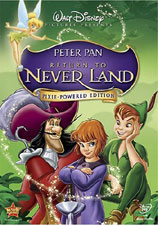
is available to buy now from Amazon.com
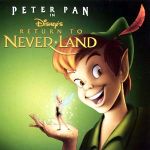
Our special appreciation to Jonatha and Joel for their time and kindness!
These articles were originally published in French at Media Magic. Jonatha Brooke and Joel McNeely‘s interviews are reprinted here by exclusive arrangement and with express permission from their author, Jérémie Noyer. English version ©Animated News & Views.



